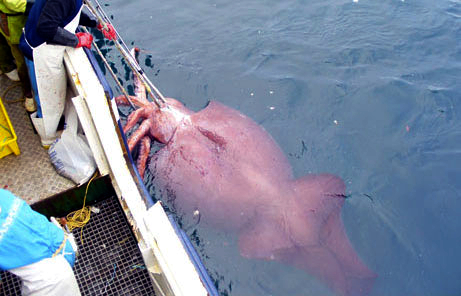Overseas researchers have advanced a startling explanation of the dinner-plate-sized eyes in the world’s biggest specimen of the deep-water colossal squid (Mesonychoteuthis hamiltoni) which New Zealand scientists investigated in 2008.

The female squid was caught in the Ross Sea off Antarctica’s northern coast in 2007, and when it was thawed at Te Papa, one of its eyes was found intact.
At the industrial-scale defrosting, Swedish professor Eric Warrant of the University of Lund — who specialised in vision in invertebrates — said: “It has a huge lens the size of an orange and captures an awful lot of light in the dark depths in which it hunts”.
Now Dr Warrant and his colleague at Lund University, Dan-Eric Nilsson, teamed up with American researchers to show that the enormous eyes of giant and colossal squid may help them spot predatory sperm whales in their dim undersea habitat.
The colossal and giant squid eyes can grow to 27cm in diameter, with pupils 9cm across, but the researchers said that eyes bigger than an orange would normally take more energy to grow and maintain than they returned in vision benefits.
But the giant eyes allowed in more light, enabling an animal to detect lower levels of contrast in their dim environment, such as tthe bioluminescence given off by ocean plankton dispersing as a whale swims through and disturbs them – and sperm whales are a major predator of big squid.
The scientists are arguing in the latest journal of Current Biology that predation by large, toothed whales that has driven the evolution of gigantism in the eyes of these squid eyes, so that they can spot such predators from as far away as 120m, and gain enough time to escape. Another of the researchers, Sönke Johnsen, a biologist at Duke University, said the design of the squid’s eye enabled it to spot the whale’s movement over “freakishly long distances” — potentially a similar range over which whales can detect the squid with a type of sonar.
The paper is speculative, and the researchers have also extended their theory to explain how ichthyosaurs, a type of swimming dinosaur, also may have used oversized eyes for detecting large targets such as the marine dinosaurs which once swam in ancient oceans. The team plans to publish its complete theory on underwater vision later this year.
Registered journalists can read details of the paper in the SMC’s Resource Library